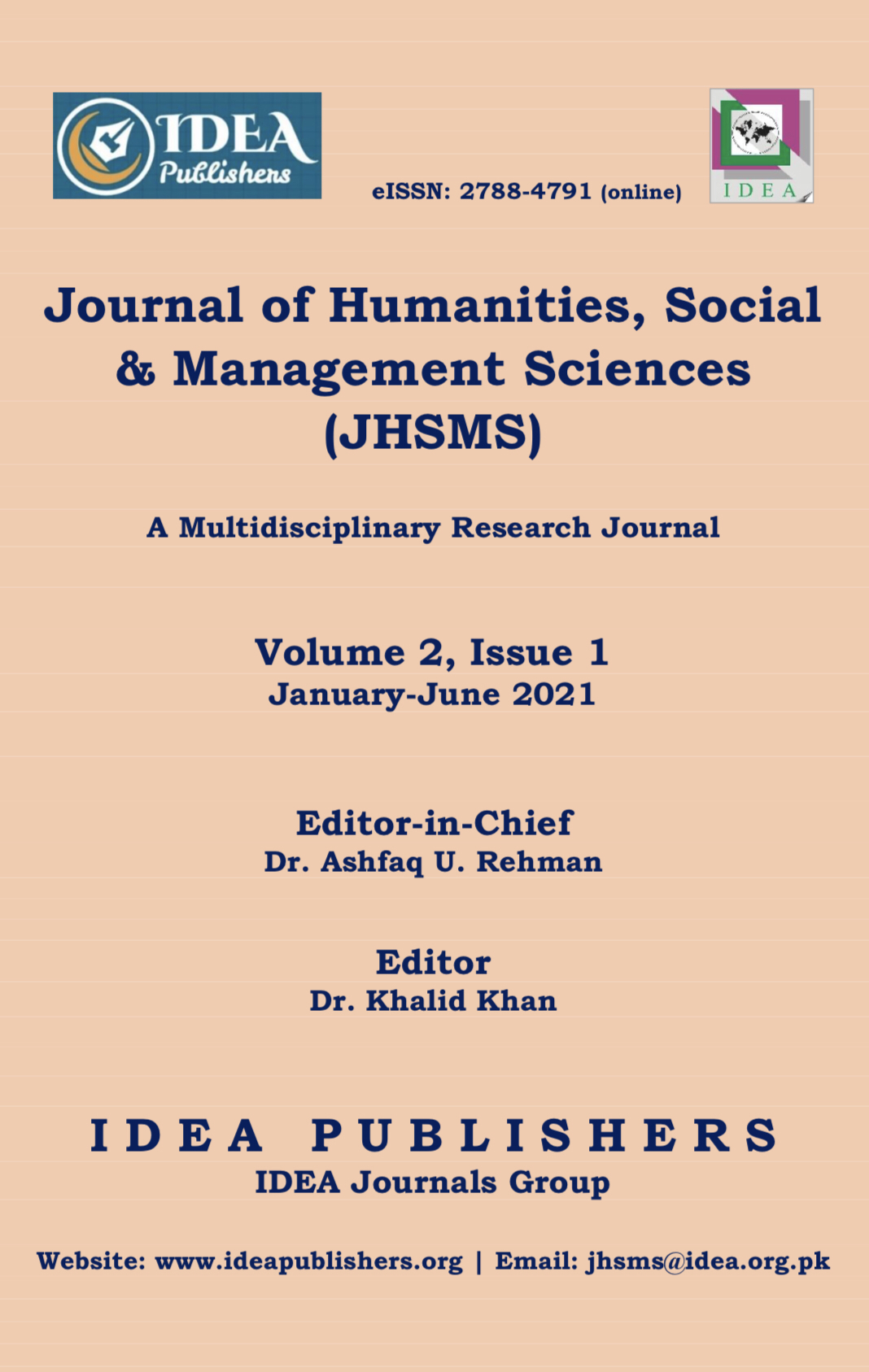War, refugees and regional implications: The impact of Afghan refugees on local society of Khyber Pakhtunkhwa, Pakistan
DOI:
https://doi.org/10.47264/idea.jhsms/2.1.11Keywords:
Saur Revolution, Afghan war, Afghan refugees, Soviet Union, socio-economic impacts, drugs, crimes, trade and commerce, prices and wagesAbstract
The migration of Afghan refugees into Pakistan started in the wake of Saur (Red) Revolution in 1978, as a result of reforms introduced by the communist regime in Kabul, Afghanistan. However the large influx of refugees to Pakistan took place soon after the invasion of Soviet Union in 1979. Pakistan provided asylum for the approximately 4.2 million refugees. They were settled in 386 camps mostly in rural as well as in urban areas of the country. But the most populous province that has large number of Afghan refugees was Khyber Pakhtunkhwa (KP) (that time N.W.F.P), which has long border (Durand line) with Afghanistan, and also has cultural, religious, and linguistics ties. This large number of immigrants generated grave consequences for Pakistan, especially for Khyber Pakhtunkhwa. They have affected the socio-economic and political life of the province. The main objective of the study was to find out the socio-economic impact of Afghan Refugees living for more than three decades in the host society of KP. An empirical and analytical methodological approach was adopted for this study. To conclude the findings, the research reveals that that Afghan Refugees have not only affected the social set-up but also the economy of the local host society by introducing various type of social evils like begging, drugs culture, Kalashnikov culture (AK-47), Galemjum culture (prostitution) and corruption.
References
Afghan Commissionerate, Hayatabad, Peshawar (N.W.F.P), Report by Ghulam Nabi Additional Commissioner Logistics, P. 12-18.
Ahmad, S. (1994, November 5). Rs. 100 b worth smuggling Subverts the Economy. Dawn
Beatty, J., & Gwynne. S. C. (1993). The outlaw law bank. Random House.
Boesen, I. W. (1990). Honour in exile: Continuity and change among Afghan refugees. In E. W. Anderson & N. H. Dupree (Eds.), The cultural basis of Afghan nationalism. (pp. 160-174). Pinter.
Commissionerate of Afghan Refugees. (1980). Afghan refugees in Pakistan.
Dawn (1998 January 1); and also see Zahid Hussain, ‘Pakistan hostage to the Mullahs’, Newsline (Karachi), May 1992, pp 28-32.
Dawn, (1998, September 2).
Directorate of Health, Peshawar (N.W.F.P) Report on Health Situations in N.W.F.P in the “Daily Mashriq”, p. 2.
Effendi, Y. (1991). The Soviet-Afghan military perspective - The waning Afghan Jihad and its effects on the Pakistan’s North West Frontier Province (N.W.F.P), Biannual Research journal (28). Area Study Centre, University of Peshawar, Pakistan.
Farr, G. M. (1990). Afghan refugees in Pakistan: Definitions, repatriation and ethnicity. In Anderson and Dupree (Eds), The cultural basis of Afghan Nationalism (pp. 134-143). Pinter Publishers
Haq, I. (1996). Pak-Afghan drug trade in historical perspective. Asian Survey, 36(10), 945-963. https://doi.org/10.2307/2645627
Herald, (1992, September 19), pp 23-28.
Hussain, F. (1982). The possible ecological impact of Afghan refugees on the natural vegetation of N.W.F.P, Pakistan. Six Monthly Journal of Research, 11(winter). 37-47.
Levitsky, M. (1989). US Assistant Sectary of State for International Narcotics, on Drug Trafficking to House Committee (Washington, DC: Government Printing Office, 8 January 1989), pp 235-456.
Rizvi, H. A. (1984). Afghan refugees in Pakistan: Influx, humanitarian assistance and implications. Pakistan Horizon, 37(1), 40-61. https://www.jstor.org/stable/41403907
Refugee Council in association with the British Agencies Afghan groups. (May 1991). “Silent Voices # 1”, May 1991, p. 14.
Samadani, Z. (1982). ‘The Afghan refugees in Pakistan: the human aspect’, Pakistan and Gulf Economist, 9-Samadani, Zafar. 1994. ‘Pakistan’s forest resources: hazards of depletion’, Dawn, 11-17 June 1994.
Shahid, S. (1994, March 19). Cross border illegal Trade on Pak-Afghan border. The News.
Statistical Survey (2000-2001). Govt. of Pakistan Survey.
Statistical Survey (2003). Govt. of Pakistan Survey.
The Daily Mashriq (2000, December 2). Afghan Refugees and Social Evils in Local Society of N.W.F.P.
The Economist, (1987, December 20), London. Cross border smuggling on Pak-Afghan border.
The New York Times. (1987, September 21). Pakistan Govt. Advertisement.
The Pakistan Times, 6 April 1995; Pakistan Narcotics Control Board, Survey on Drug Abuse in Pakistan (Islamabad: Narcotics Control Board, 1988-89), pp 7-86; and Ikramul Haq, Pakistan From Hashish to Heroin (Lahore: Annoor Printers & Publishers, 1991).
Kartha, T. (1997). The diffusion of light weapons in Pakistan. Small Wars & Insurgencies, 8(1), 71-87. https://doi.org/10.1080/09592319708423163
The Daily Mashriq. (1992). Dost, Muhammad. Lashminia in Afghan Refugees’ Camps.
Weinbaum, M. G. (1993). The Impact and legacy of Afghan refugees in Pakistan. In J. Henery
Korsen (Eds.), Contemporary problems of Pakistan. Westview Press, 1993.
Yousafzai, R. (1991, November 11). The Economic Burden of Afghan Refugees. Frontier Post.
Downloads
Published
How to Cite
Issue
Section
License
Copyright (c) 2021 Asghar Khan, Irfan Khan, Noor Ullah Khan

This work is licensed under a Creative Commons Attribution-NonCommercial 4.0 International License.
Please click here for details about the Licensing and Copyright policies of IDEA-PG.















